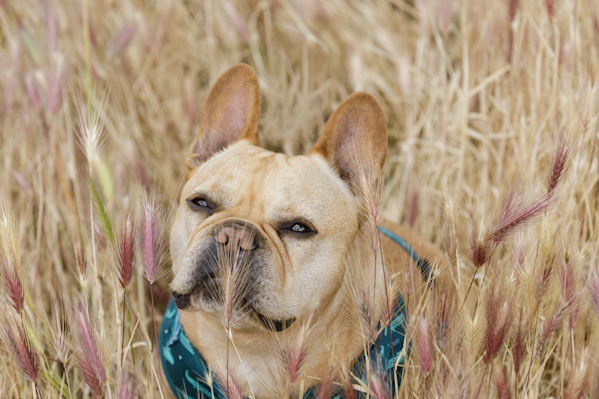If you take your dog on a lot of hikes in the summer months, chances are they’ve come across a foxtail or two.
These pesky pointed seeds can burrow their way through a lot, including your pup’s sniffing nose or tender paws. Once they get a hold on your dog, they can also cause infection, discomfort and—in extreme cases—even death.
The good news is that you can take steps to reduce your dog’s risk from foxtails. Read on to learn more about what a foxtail is, what it can do to your dog, and how you can prevent them from getting stuck on your furry friend.
What are foxtails?
Foxtails are the seed-like tops found on several species of grasses. When the grass dries out and goes to seed, the foxtails break off and have a sharp tip that is designed to burrow into the ground (or in some cases, sadly, into your pup and even yourself if you’re not careful).
Foxtails exist in most states in the U.S. and are most common in the spring and summer months, though some places like California can have foxtails year-round. You and your pup can come into contact with them in any grassy area—your backyard, hiking trails, and any fields you may take your dog to for a romp.
Read: 4 Ways To Keep Your Dog Active — And Why It's So Important
Why are foxtails dangerous to dogs?
“Foxtails are dangerous to everyone because of how they're designed to work,” explains Dr. Jo Myers, DVM.
“As the seeds migrate forward, they will push their way through skin, muscle, fat, and pretty much anything except for bone. They're not exactly sterile either, so it's not unusual for a wound created by a foxtail to become infected. Depending on the location of this wound, a migrating foxtail has the potential to be life threatening in a worst-case scenario.”
While any mammal can get infections from foxtails burrowing into their skin, dogs are especially prone to them because they push their faces into the grass to sniff things. When dogs do this, foxtails can wriggle their way into their eyes, nose, mouth, and ears.
How do you know if your dog has a foxtail?
Foxtails can end up getting stuck in many places on your pup’s body, such as their toe pads, ears, nose, and eyes.
If your dog gets a foxtail on their toe pad, the seed usually comes out of the top part of the foot and leaves a dark pink blister. If your dog has a foxtail in their ear canal, they may shake their head, hold one ear lower than the other, or paw at their ear.
In the event that a foxtail ends up in your pup’s nose, they may start sneezing and have nasal discharge. If they get one in the mouth, your dog may like their lips and paw their muzzle as well.
Last but not least, foxtails can also get trapped in the skin folds around the eyelids.
“The symptoms are exactly what you would expect any time you have something irritating in the eye,” Dr. Myers explains. Those symptoms include redness, swelling, discharge, excessive tearing, discomfort, pawing at the eye, and holding the eye closed.
What to do if your dog has a foxtail
“If you can see the foxtail and safely remove it, do so,” says Dr. Myers. “Typically, no additional treatment is necessary as long as the wound is not in a tricky location and doesn't appear to be seriously infected.”
If your dog has a foot sore, Dr. Myers recommends soaking the paw twice daily for 10 minutes in an Epsom salt solution. Foxtails in other parts of a dog’s body like the nose and ear, however, may require a vet visit. Depending on the severity of the infection, your vet may sedate your dog and use special equipment to locate and remove the foxtail.
How to prevent your dog from getting foxtails
“When it comes to foxtails, an ounce of prevention is definitely worth a pound of cure,” says Dr. Myers.
The best way to prevent your pup from getting some unwanted hitchhikers is to avoid going on hikes or visiting grassy areas during the summer months. If you have a yard, it also helps to mow it before the grass goes to seed.
Keeping your dog well-groomed can also help reduce the risk of foxtails.
“Make sure his hair coat is healthy, clean, and free of mats,” suggests Dr. Myers. “If he has long hair on his feet, trimming may help reduce the likelihood of picking up foxtails.”
Finally, if you have an active dog and foxtail terrain is something you and your pup can’t avoid, you can also try purchasing foxtail booties or a mesh field guard mask for your dog to protect their feet and head from any potential foxtail issues.
